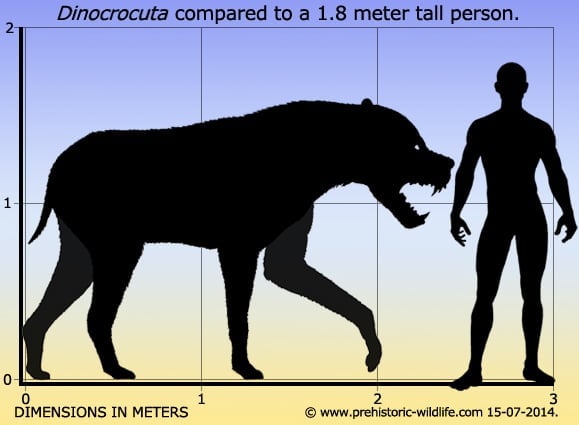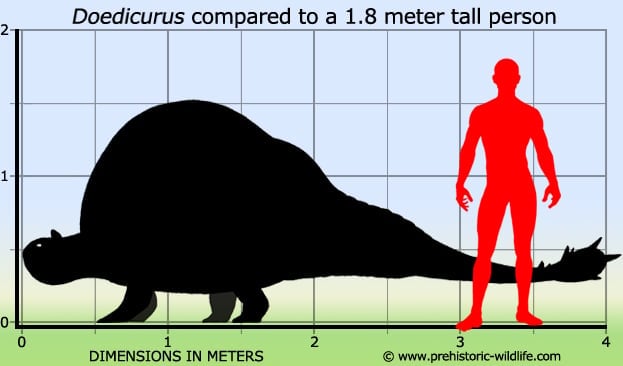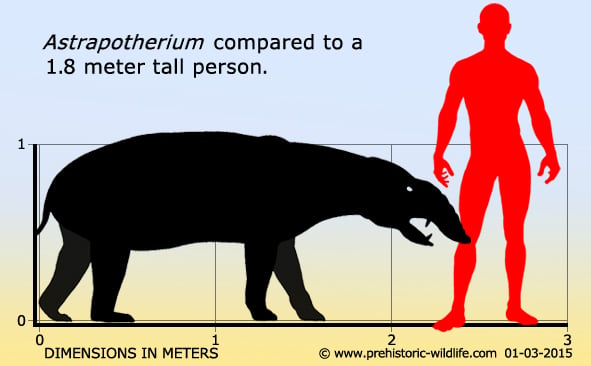Tix Mascot
Tech guru
Italy is my second homeland
Posts: 11,097  Mini-Profile Background: {"image":"http://4.bp.blogspot.com/-X5mhw13BJ7Y/TwKeZ3uM7YI/AAAAAAAABPw/D82go4Ny_8E/s1600/italy-background-8-787281.jpg","color":""}
Mini-Profile Text Color: 0ef8f1
Mini-Profile Name Color: f40d39
Year of Birth: 1961
Nationality: Norwegian
Mini-Profile Background: {"image":"http://4.bp.blogspot.com/-X5mhw13BJ7Y/TwKeZ3uM7YI/AAAAAAAABPw/D82go4Ny_8E/s1600/italy-background-8-787281.jpg","color":""}
Mini-Profile Text Color: 0ef8f1
Mini-Profile Name Color: f40d39
Year of Birth: 1961
Nationality: Norwegian
|
Post by Tix Mascot on Jul 13, 2021 10:34:33 GMT
Yikes it looks like a long legged rat. With a percentage of hyena! |
|
|
|
Post by Talira Greycrest on Jul 13, 2021 13:39:54 GMT
Name: AcrophyseterPronunciation: Ack-roe-fie-set-erMeaning of name: "Acute sperm whale"Species: A. deinodon, A. robustusSize: Uncertain, but is estimated to have measured up to 4.3 metres longFamily: UncertainDiet: CarnivoreFirst fossils found: Known only from two partial skulls discovered in Peru. A. deinodon named by O. Lambert, G. Bianucci and C. de Muizon in 2008. A. robustus named in 2016.Lived: Depending on species, lived between 13.82 and 5.333 million years ago from the Serravallian stage of the Middle Miocene through to the Messinian stage of the Late Miocene in the oceans off the coast of what is now Peru.

|
|
|
|
Post by Joey12 on Jul 14, 2021 4:38:25 GMT
Looks like the Ray was a small one compared to some I have seen on nature channels.
|
|
|
|
Post by Joey12 on Jul 14, 2021 4:40:49 GMT
The last one reminds me of a Beluga Whale.
|
|
|
|
Post by Talira Greycrest on Jul 14, 2021 12:26:02 GMT
Name: PacifichelysPronunciation: Pah-sif-ik-chel-issMeaning of name: "Pacific shell"Species: P. urbinai, P. hutchisoniSize: UncertainFamily: CheloniidaeDiet: Durophagous. Fed on crustaceans and hard-shelled mollusks. First fossils found: Known from two partial skeletons discovered in the Pisco Formation of Peru and the Temblor Formation of California. Originally thought to be a species of Euclastes, P. hutchisoni named in 2003. P. urbinai named by James F. Parham and Nicholas D. Pyenson in 2010.Lived: Depending on species, lived between 15.97 and 11.608 million years ago from the Langhian stage of the Middle Miocene through to the Tortonian stage of the Late Miocene in the oceans off the coasts of what is now Peru and California. Skull of P. urbinai Skull of P. urbinai
|
|
Tix Mascot
Tech guru
Italy is my second homeland
Posts: 11,097  Mini-Profile Background: {"image":"http://4.bp.blogspot.com/-X5mhw13BJ7Y/TwKeZ3uM7YI/AAAAAAAABPw/D82go4Ny_8E/s1600/italy-background-8-787281.jpg","color":""}
Mini-Profile Text Color: 0ef8f1
Mini-Profile Name Color: f40d39
Year of Birth: 1961
Nationality: Norwegian
Mini-Profile Background: {"image":"http://4.bp.blogspot.com/-X5mhw13BJ7Y/TwKeZ3uM7YI/AAAAAAAABPw/D82go4Ny_8E/s1600/italy-background-8-787281.jpg","color":""}
Mini-Profile Text Color: 0ef8f1
Mini-Profile Name Color: f40d39
Year of Birth: 1961
Nationality: Norwegian
|
Post by Tix Mascot on Jul 14, 2021 18:59:59 GMT
Big cavity in the nose region. Blow hole?
|
|
|
|
Post by Joey12 on Jul 15, 2021 9:10:24 GMT
Depending on the size those are really big eyes.
|
|
|
|
Post by Talira Greycrest on Jul 15, 2021 10:25:04 GMT
Big cavity in the nose region. Blow hole? That's just the nasal cavity. |
|
|
|
Post by Talira Greycrest on Jul 15, 2021 10:41:40 GMT
Name: DinocrocutaPronunciation: Dy-noe-crow-cu-tahMeaning of name: "Terrible hyena"Species: D. gigantea, D. algeriensis, D. salonicae, D. senyurekiSize: The largest species, D. gigantea, measured around 2.3 metres long, 1.9 metres tall and weighing 300kgs.Family: Percrocutidae.Diet: CarnivoreFirst fossils found: Known from several specimens discovered in Spain, Central China, Tibet, North Africa, Mongolia, India, Pakistan, Iran, Turkey, Bulgaria and Greece. Named in 1976.Lived: Depending on species, lived between 9.7 and 8.7 million years ago during the Tortonian stage of the Late Miocene in what is now Iran, Turkey, Bulgaria, Spain, Central China, Tibet, North Africa, Mongolia, India, Pakistan and Greece.
|
|
Tix Mascot
Tech guru
Italy is my second homeland
Posts: 11,097  Mini-Profile Background: {"image":"http://4.bp.blogspot.com/-X5mhw13BJ7Y/TwKeZ3uM7YI/AAAAAAAABPw/D82go4Ny_8E/s1600/italy-background-8-787281.jpg","color":""}
Mini-Profile Text Color: 0ef8f1
Mini-Profile Name Color: f40d39
Year of Birth: 1961
Nationality: Norwegian
Mini-Profile Background: {"image":"http://4.bp.blogspot.com/-X5mhw13BJ7Y/TwKeZ3uM7YI/AAAAAAAABPw/D82go4Ny_8E/s1600/italy-background-8-787281.jpg","color":""}
Mini-Profile Text Color: 0ef8f1
Mini-Profile Name Color: f40d39
Year of Birth: 1961
Nationality: Norwegian
|
Post by Tix Mascot on Jul 15, 2021 16:46:08 GMT
A hyena with a bear's head. LOL
|
|
|
|
Post by Talira Greycrest on Jul 16, 2021 7:26:41 GMT
A large, heavily-armoured relative of today's armadillos: Name: DoedicurusPronunciation: Day-dih-core-usMeaning of name: "Pestle tail"Species: D. clavicaudatusSize: Measured between 3.5 and 4 metres long, 1.5 metres tall and weighing between 1.4 and 2.3 metric tonnes.Family: Glyptodontidae.Diet: Herbivore. Fed on low-growing vegetation.First fossils found: Known from several specimens discovered in Uruguay and northeastern Patagonia, Argentina. Named by German Argentine zoologist, entomologist, herpetologist and botanist, Karl Hermann Konrad Burmeister, in 1874.Lived: 1.2 million to 11,700 years ago from the Calabrian stage of the Middle Pleistocene through to the Tarantian stage of the Late Pleistocene in what is now Uruguay and northeastern Patagonia, Argentina.
 |
|
Tix Mascot
Tech guru
Italy is my second homeland
Posts: 11,097  Mini-Profile Background: {"image":"http://4.bp.blogspot.com/-X5mhw13BJ7Y/TwKeZ3uM7YI/AAAAAAAABPw/D82go4Ny_8E/s1600/italy-background-8-787281.jpg","color":""}
Mini-Profile Text Color: 0ef8f1
Mini-Profile Name Color: f40d39
Year of Birth: 1961
Nationality: Norwegian
Mini-Profile Background: {"image":"http://4.bp.blogspot.com/-X5mhw13BJ7Y/TwKeZ3uM7YI/AAAAAAAABPw/D82go4Ny_8E/s1600/italy-background-8-787281.jpg","color":""}
Mini-Profile Text Color: 0ef8f1
Mini-Profile Name Color: f40d39
Year of Birth: 1961
Nationality: Norwegian
|
Post by Tix Mascot on Jul 16, 2021 13:23:39 GMT
Seems disproportionate, but hey, look out for that spiked club of a tail!
|
|
|
|
Post by Joey12 on Jul 17, 2021 10:39:39 GMT
Yes you wouldn't want to tease this one. That tail would take you out.
|
|
|
|
Post by Talira Greycrest on Jul 17, 2021 13:41:19 GMT
Name: SansanosmilusPronunciation: San-san-oh-smilusMeaning of name: "Sansan knife"Species: S. palmidensSize: 1.5 metres long and weighing around 80kgs.Family: Barbourofelidae.Diet: CarnivoreFirst fossils found: Known from several specimens discovered throughout Europe. Named by Miklós Kretzoi in 1929.Lived: 13.6 to 11.1 million years ago from the Serravallian stage of the Middle Miocene through to the Tortonian stage of the Late Miocene throughout what is now Europe. Sansanosmilus skull Sansanosmilus skull
|
|
|
|
Post by Talira Greycrest on Jul 18, 2021 13:27:28 GMT
Name: AstrapotheriumPronunciation: As-trah-po-thee-ree-umMeaning of name: "Lightning beast"Species: A. burmeisteri, A. guillei, A. magnum, A. ruderariumSize: 2.5 metres long, 1 metre tall and weighing around 1 metric tonne.Family: Astrapotheriidae.Diet: Herbivore. Fed on low-growing vegetation.First fossils found: Known from well-preserved specimens discovered in Chile and Argentina. A. magnum named by English palaeontologist, Sir Richard Owen, in 1853. A. ruderarium named in 1902. A. burmeisteri named in 1891. A. guillei named in 2019.Lived: Depending on species, lived between 21 and 16.3 million years ago from the Aquitanian and Burdigalian stages of the Early Miocene in what is now Chile and Argentina.

|
|